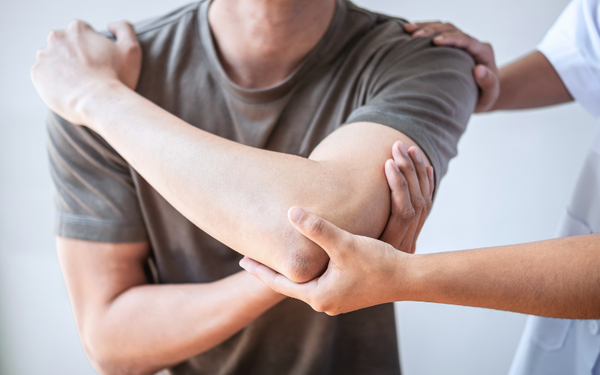No Products in the Cart
Pickleball is known for being accessible to players of all ages and skill levels, providing a great way to stay active and socialize. However, like any sport, pickleball comes with its own set of injury risks. Understanding these risks and how to prevent them is crucial for every player who steps onto the court. In this article, we'll explore common pickleball injuries and share essential tips for staying safe and enjoying the game injury-free.

Pickleball is a lower-impact sport compared to many others, but injuries can still occur, particularly in the areas of overuse, falls, and strains. Here are some of the most common injuries pickleball players might encounter:
Ankle Sprains: Quick directional changes and lateral movements can lead to ankle sprains, where the ligaments around the ankle are stretched or torn.
Tennis Elbow: Despite the name, tennis elbow is also common in pickleball. It's caused by repetitive use of the forearm muscles, leading to pain around the outside of the elbow.
Rotator Cuff Injuries: The rotator cuff in the shoulder can become injured from repetitive overhead movements, like serving or smashing in pickleball.
Knee Injuries: The knee joint can suffer from various issues, including ligament tears, tendonitis, and meniscus injuries, due to the sport's quick stops and starts.
Wrist Injuries: Wrist strains or sprains can occur from the impact of hitting the ball or from a fall.
Back Pain: Prolonged play, especially without proper technique, can lead to back strain or pain.
Staying injury-free in pickleball involves a combination of proper preparation, technique, and self-care. Here are key strategies to help prevent injuries:
Warm-Up and Cool-Down: Begin each session with a warm-up to get your blood flowing and muscles ready for the game. This might include light jogging, dynamic stretches, or practice shots. After playing, cool down with slower, static stretches to help your muscles recover.
Proper Technique: Learning and maintaining proper playing techniques is vital. This includes correct posture, paddle grip, and stroke mechanics. Consider taking lessons from a certified instructor to ensure you're playing efficiently and safely.
Strength and Flexibility Training: Incorporating strength and flexibility exercises into your routine can greatly reduce injury risk. Focus on core strength, leg muscles, and flexibility in your arms and shoulders. Yoga and Pilates are excellent for building strength and improving flexibility.
Use the Right Equipment: Wear appropriate shoes that provide good support and traction to prevent slips and falls. Ensure your paddle is the right size and weight for you to avoid strain on your arms and shoulders.
Play on Suitable Surfaces: Playing on a proper pickleball court with a smooth, even surface can reduce the risk of falls and ankle injuries. Avoid playing on uneven or slippery surfaces.
Hydration and Nutrition: Stay hydrated and nourished. Dehydration and low energy levels can lead to fatigue, impairing your concentration and physical ability and increasing the risk of injury.
Rest and Recovery: Listen to your body and give it time to rest and recover, especially after intense play or if you're feeling pain. Overuse is a common cause of injuries, so taking regular breaks is essential.
Pace Yourself: Especially for beginners or those returning after a break, it's important to gradually increase playing time and intensity to avoid overexerting yourself.

To further prevent injuries, specific exercises tailored for pickleball can be very beneficial. Here are some targeted exercises that can be incorporated into your routine:
Leg Squats: Strengthen your thighs, hips, and buttocks with squats. They improve your lower body strength, which is crucial for quick movements in pickleball.
Lunges: Lunges work on your lower body muscles and help in improving balance and coordination.
Core Exercises: Strengthening your core with exercises like planks or Pilates can improve your stability power, and reduce the risk of back injuries.
Shoulder Strengthening: Exercises like shoulder presses and rotator cuff stretches can help in preventing shoulder injuries.
Wrist and Forearm Strengthening: Use light weights or resistance bands to strengthen the muscles around your wrist and forearm. This can help prevent strains and tennis elbow.
Flexibility Training: Incorporate stretching exercises into your routine to improve flexibility, particularly in your arms, shoulders, and legs. Yoga can be especially beneficial for this.
Good technique not only improves your game but also minimizes injury risk. Here are some tips for refining your technique:
Paddle Grip: Holding your paddle too tightly can lead to wrist and elbow strain. Practice a relaxed grip to allow more fluid movements.
Stance and Footwork: Maintain a balanced stance and practice proper footwork. This helps in reducing the stress on your knees and ankles.
Stroke Mechanics: Work on your stroke mechanics, ensuring smooth and controlled movements. This reduces the strain on your shoulder and elbow.
Avoid Overreaching: Overreaching for shots can lead to falls or muscle strains. Position yourself properly and make use of footwork to reach shots.
Play Smart: Use strategy over strength. Smart placement of shots can be more effective and less physically demanding than always playing with power.
Playing in a pickleball tournament can be an exciting and rewarding experience, but it also brings its own set of challenges in terms of injury prevention. Here are some tips to stay safe during tournaments:
Adequate Preparation: Ensure you're well-prepared physically for the tournament. This includes being consistent with your exercise and practice routine leading up to the event.
Proper Warm-Up: Before each match, perform a thorough warm-up to get your muscles ready and reduce the risk of injury.
Hydration and Nutrition: Tournaments often mean long days and multiple games. Stay hydrated and eat nutritious foods to maintain your energy and focus.
Rest Between Matches: Utilize the time between matches to rest and recover. Stretch lightly and stay loose without overexerting yourself.
Pace Yourself: Be mindful of your physical limits. It's better to play within your ability than to push too hard and risk injury.
Mental Preparation: Stay mentally focused and manage stress. Tournaments can be mentally taxing, and a calm, focused mind is less prone to making mistakes that could lead to injury.
Different players have unique considerations when it comes to injury prevention. Here's some tailored advice:
For Beginners: Focus on learning proper techniques right from the start. This will help prevent bad habits that could lead to injuries.
For Senior Players: Pay extra attention to joint health. Incorporate low-impact exercises and stretches into your routine, and don't hesitate to modify your play to suit your physical capabilities.
For Competitive Players: Balance intense training with adequate rest. Listen to your body's signals, and don't ignore pain or discomfort.
For Young Players: Emphasize the importance of proper technique, warm-up, and cool-down routines. Young players should also be encouraged to play multiple sports to avoid overuse injuries from specializing too early.
For Returning Players: If you're returning after a break or injury, ease back into the game gradually. Ensure you've fully recovered and consider consulting with a physical therapist or coach for guidance.

Pickleball is a sport that offers immense fun, great exercise, and a fantastic community. However, staying aware of the potential for injuries and taking proactive steps to prevent them is crucial for players of all levels. Remember to always warm up before playing, focus on proper technique, and incorporate strength and flexibility training into your routine. Use the right equipment, stay hydrated and well-nourished, and don't underestimate the importance of rest and recovery.
No matter if you're a beginner, a senior player, a competitive athlete, or returning after a break, the key to enjoying pickleball safely lies in playing smart and taking care of your body. By following the tips and strategies outlined in this article, you can minimize your risk of injury and ensure that you continue to enjoy the many benefits of this wonderful sport for years to come.
So, grab your paddle, step onto the court, and remember: the best way to enjoy pickleball is to play it safe!
Check out Born to Rally blog to read more interesting pickleball-related articles.